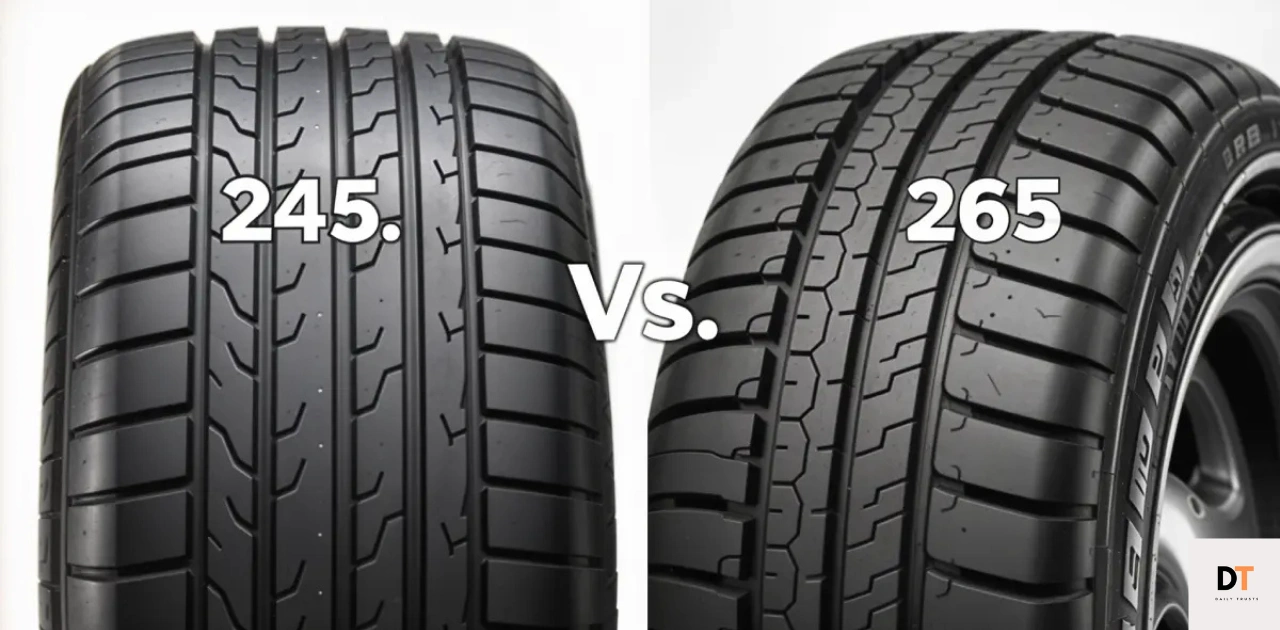245 vs. 265 Tires: A Detailed Analysis of Gas Mileage, Performance, and Practicality
The comparison between 245 vs 265 gas mileage per gallon Tires is an investigation into the core of automotive engineering and layout, not just a mathematical problem. This fascinating tale is about comfort, control, speed, and safety—it’s not just about rubber on asphalt. We’ll examine two well-known tire sizes, 245 and 265 in detail in this excessive-octane conversation. We’ll be exploring their specific features, how each affects the overall performance of your car, and which may be more suited to your riding preferences.
Have you ever wondered why one large variety would match your car better than another? Are you curious in how your rides can be drastically controlled by a small-digit difference? So fasten your seatbelt! We’re jumping right in to the fascinating comparison between 245 and 265 tires, an excursion that is sure to reveal significant differences that all car owners must be aware of.
Major differences between 245 and 265 tires
1. The Width Factor
Tire sizes, particularly breadth, are one of the most important differences between 245 and 265 tires. The width of a tire size designated as “245” is roughly 245 millimeters, whereas the width of a tire size designated as “265” is roughly 265 millimeters. This variation in tire widths has a significant impact on how you ride and may be crucial to the operation of your vehicle.
2. Contact Surface
A wider floor area that contacts the street is the direct result of a 265 tire’s increased width as compared to a 245 tire. As a result, expect improved traction and stability when driving a car equipped with wider tires. However, keep in mind that larger tires may also result in lower fuel efficiency due to increased rolling resistance; so, you must balance these homes against each other’s requirements or options.
3. Size Matters in Tires
A closer look at those tire classifications reveals that the “245” stands for the tire’s nominal width. In other words, its length from sidewall to sidewall is roughly 245 millimeters. However, the number “265” indicates a larger tread face that is about 265 millimeters wide. What does all of this imply, then? You are essentially experimenting with your car’s contact patch on the road when you choose larger or smaller tires (for example, choosing between a size 245 and a length 265).
4. Performance
Aside from tire width, performance characteristics are another significant area where these two tire types diverge significantly. The 265 tires might offer more traction when braking, cornering, and accelerating since it has a larger contact surface with the pavement than its counterpart. But remember that bigger isn’t necessarily better. Given their greater surface area involvement with roadways, a 265 may appear to be the greatest choice for enhancing driving dynamics.
5. Smooth Ride vs Hefty Costs
If you desire smooth travel and don’t mind paying a little bit extra for petrol while prioritizing safety, investing in a size 265 might be worthwhile! However, the tried-and-true size-245 can seem like a wise decision if cost is your top priority because it will roll against surfaces with less resistance, which will lead to reasonable fuel economy.
The importance of tire size and its impact on performance
The following are ten crucial factors to take into account when comparing 245 and 265 tires:
- Improved Grip: Due to their broader diameter, 265 tires offer a greater surface contact area than 245 tires. When braking and turning, improved grip is the outcome.
- Better Stability: The broader footprint increases overall stability while moving quickly or making sudden turns.
- The trade-off in Acceleration: Although wider tires provide more grip, they may slightly impair acceleration due to increased rolling resistance.
- Fuel Economy: Fuel efficiency may be slightly impacted by narrower tires, like the 245s, because they typically have less rolling resistance and aerodynamic drag than larger tires, like the 265s.
- Comfort Levels: Compared to their narrower counterparts, wider tires frequently absorb shock better and give a smoother ride over bumps.
- Single vs. Dual Setup: Depending on the type of vehicle you drive (SUVs or pickup trucks), a dual rear tire layout may enhance weight distribution for large loads, but it may also reduce fuel efficiency and make some terrains more challenging to traverse.
- Weight Handling capability: Upgrading from 245 to 265 tires will allow your car to securely carry more weight because a higher tire number denotes an increase in load-bearing capacity.
- Riding Noise: Wider tires can generally produce higher noise levels, though this would vary greatly depending on a variety of factors, including tread patterns.
- Winter Performance: In general, narrower tires, such as the 245 model, work better in the winter because they apply more pressure per square inch to roads that are slippery or covered with snow.
